Horrific Inquiry: HOUSE OF WAX (1953)
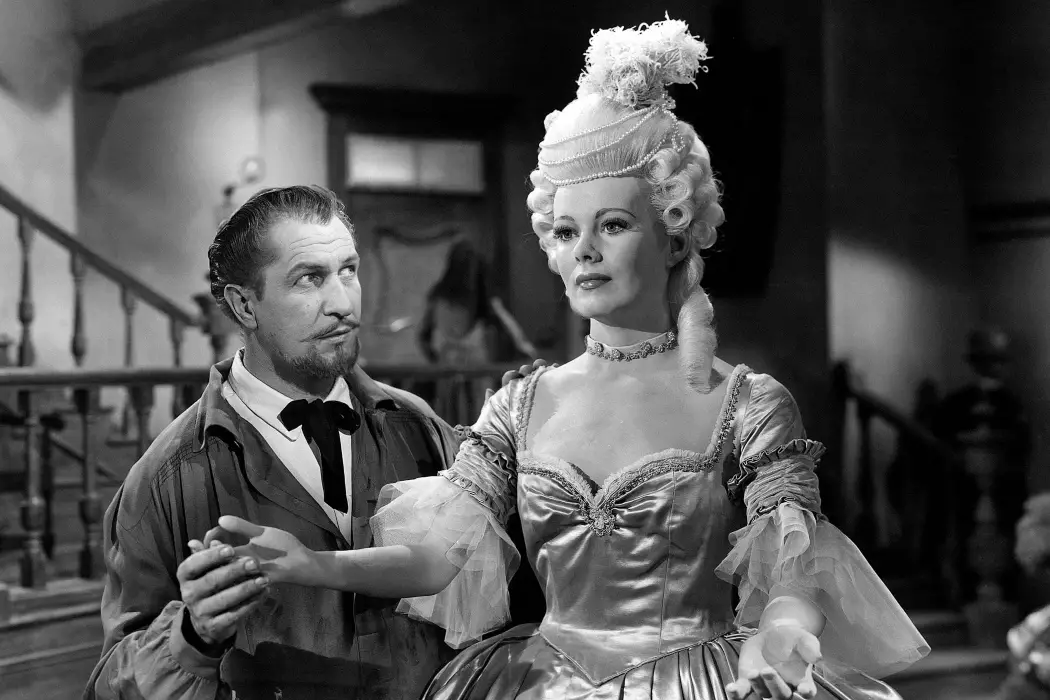
Stephanie Archer is 39 year old film fanatic living in…
Welcome back to the newest, and at times goriest, column here at Film Inquiry – Horrific Inquiry. Twice a month, I will be tackling all things horror, each month bringing two films back into the spotlight to terrify and frighten once more. And occasionally looking at those that could have pushed the envelope further. Join us as we dive deep into the heart of horror, but warning, there will be spoilers.
For January’s second pick of the month, I felt a driving desire to satisfy a long overdue watch, one whose leading star has been synonymous with horror for over 60 years – the indomitable Vincent Price. While there is an unrelenting supply of films that Price had fronted, it was House of Wax that called for my attention, vying for rebirth and recognition 68 years after its release. While my current experience with the film would undeniably be different from those who witnessed its induction in cinemas – its Technicolor and 3-D filming heightening the horror of the time – House of Wax is a film in horror history that, while experiencing varying success with each of its three inductions, can not be overlooked.
Originally released in 1933 as The Mystery of the Wax Museum, fronted by Lionel Atwill and Fay Wray (and following a decade of films released in the 1920s that dealt with disfigurement), 1953 would see André De Toth and Vincent Price resurrecting the tale of the doomed sculpture turned serial killer, his permanent disfigurement leading him to pursue other means of achieving his art. Looking at the film now, generations separated from its release, it still holds up, maintaining an impressive tension through Price‘s undeniable performance, David Buttolph‘s dramatic and urgent score, and Gordon Bau‘s impressive makeup success. I would be lying if I said I was not impressed. What does not stand the test of time, however, is its perspective of women and the female form, an expected criticism of intelligence and independence coupled with a surprising amount of brutality towards women in the background, a predecessor to the brutality that becomes front and center in the decades to come.
“Wax on, Wax off”
House of Wax opens with Buttolph‘s loud and dramatic score filling your ears, tension immediately laid and insinuated. Coupled with opening credits dripping with wax in sharp yellows, oranges, and reds, viewers are made effectively aware they will not have to wait long for the action to begin. And the film keeps the promise and delivers. As Professor Henry Jarrod (Price) works in his shop, his business partner Matthew Burke (Roy Roberts) arrives with a fury of ideas on how they can increase the Museum’s revenue – all with the intention of reclaiming his investment for another venture. Jarrod reassures him he may be able to settle their accounts tonight, as a new hopeful investor is set to come to the museum that very evening. While Sidney Wallace (Paul Cavanagh) seems keen to invest, he can not make any decisions until he returns from his trip to Egypt in three months.
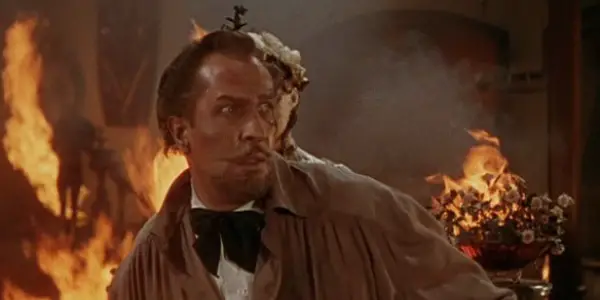
Refusing to wait as new prospects lie on the immediate horizon, Burke proposes he and Jarrod burn the place down to collect the insurance money. Horror hits Jarrod at the thought of losing his precious pieces of art, especially his pièce de résistance Marie Antoinette and he fights off Burke, at first getting the upper hand, but in the end overpowered and left to die in the engulfing flames of destruction and greed. As the building explodes, the gas lights fueling the flames, Jarrod and his museum seem all but lost.
Fast forwarding, viewers are reintroduced to Burke, now accompanied by his date Cathy (Carolyn Jones, best known as Morticia Addams in the 1964 TV series The Addams Family), each meeting their untimely deaths at the hands of a grotesquely scarred man, their resemblances eerily residing in the new Wax Museum. While mystery shrouds the true origin of these wax statues, Sue Allen (Phyllis Kirk) begins to question her own sanity, haunted by the image of the scarred man and the similarities within the museum. Yet with the face of Marie Antoinette, her time too may be running out.
Sculpting a Horror Remake
Watching House of Wax, I was surprised by the intense pace of action the film dove into – maintaining its pace throughout. While many film narrative structures and stories can seem drawn out years later, House of Wax was still a fascinating and engrossing watch. While it does threaten to loose some of your attention here and there, overall its mystery and direction still keep the viewer locked in.
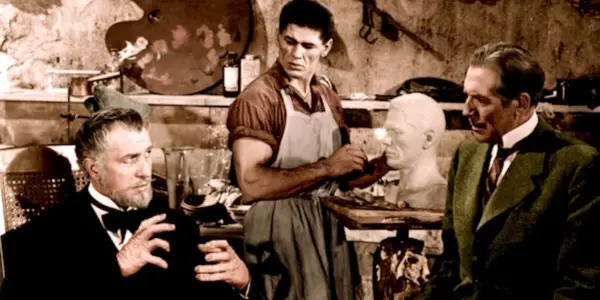
What is also intriguing is viewing the film without its 3D intention. While you can see where the 3D was intended by the filmmaker, it does not distort or break the continuity of the film. Fists and items are thrown towards the camera in fight scenes and a paddle ball is hurled toward audiences (accompanied by a breaking of the fourth wall as well), yet it still fits within a standard film. Yet, while you may not have the chance to experience the 3D intention, left to only witness its potential, House of Wax boasts different aspects that have it cleverly standing out from other horror films of the time. The makeup and set design give way to a terrifying and at times gory display. From the scarred face of Price‘s Jarrod to the wax pouring off the statues at the film’s beginning, there is a devilishly playful nature to the showcase of House of Wax.
Vincent Price is horror gold here, in the beginning, the fragile line of insanity and art clearly present in his mannerisms and his eyes as he speaks and looks at his creations. Both speak to the care and delicacy his character feels and exerted towards each creation, making their disastrous end that more devastating. While these two sides of Price‘s character mimic a kind of Jekyll and Hyde, the artist versus the killer, there is a resonating vibe that is constant – the desire to continue his works at all cost. As his ability to “reinvent” his talent grows so does his stature, climaxing into a powerful and dramatic display of superiority and control in the final act of the film, Price‘s Jarrod towering over Sue Allen, his eyes no longer looking in wonder but in power. That is before Sue Allen breaks his mask, cracking the false reality Jarrod has crafted for himself. From here, his character becomes smaller, giving the professor, and Price, the third transition of stature. And Price once again delivers, the intensity of achieving his life’s work slowly seeping away from him, the camera rising above him, his Jarrod quickly shriveling into fear and eventually obscurity.
“Skirts”
House of Wax contains what you would expect of female representation in the 1950s. They are easily frightened, worried only about their figure, and always on the lookout for the match that will lead to marriage. The future is measured in money and security, especially within the character of Cathy – her casual and callous disregard for her former beau whose prospects ended when he “killed” himself. While Sue Allen is painted as a woman struggling to make it in NYC, she still has the prospect of Scott Andrews (Paul Picerni) to look forward to. And the way women are referred to – no shock there either, women referred to by the police as “skirts” and morgue personnel reacting to a corpse lunging forward saying, “like a woman, they always have to get the last word.”
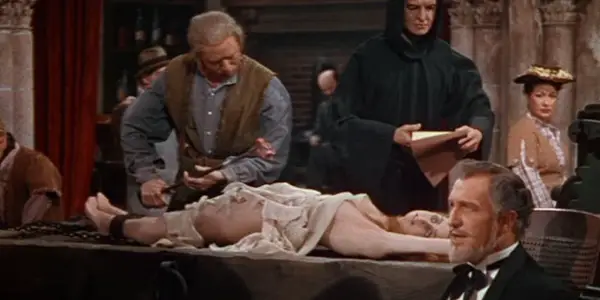
Not only are these women given little depth, but their intelligence is also constantly questioned. Sue Allen especially. Sue Allen is a particularly interesting female character here. She is smart, she evades the killer and subsequently figures it all out. She knows what the truth is, yet is constantly convinced otherwise by both Scott and the police. In her first encounter with scarred Jarrod, she is smart enough to know that she needs to remove her shoes to evade the killer, the clicking on the cobblestone impossible to mask. Her gut and her intuition lead her to search for the details that could have easily gone unnoticed by the police.
And with all her smarts, she is never truly praised for her cleverness – rather in the end pays for it in the eyes and judgment of others. Convinced by Scott and the police that there was nothing to be concerned about, coupled by the fact her beau worked at the museum as an apprentice, Sue Allen allowed her guard down, entering the darkened museum alone. Having discovered the true identity of Joan of Arc, she is captured by Jarrod and his henchman Igor (Charles Bronson), stripped naked and laid out to be covered in wax. When the police storm in to rescue her, there is a moment of care as they cover her with their coat, a comforting gesture that later becomes a joke between the lines at the film’s end. But what do you expect of a film within this time period – and a horror film at that.
While I had expected the male perspective and the film’s verbal treatment of women, I was surprised to see the implied violence that resided in the background. In the films that are to follow in the decades after House of Wax, murder, and violence towards women, and in general, would become a focal point of horror. Punishments for drugs, premarital sex, and poor demeanor would bring death to many – typically only one girl surviving in the end. What is striking about House of Wax was the violence in the displays of the museums. While the first wax museum at the beginning surrounded historical figures and moments (Marie Antoinette and the Assassination of Lincoln), the second museum contained more gruesome moments in history. While there were both displays containing both male and female, there is an overwhelming amount where the women are the central figures of abuse and murder. Anne Boylen about to have her head chopped off, another woman losing her head to the guillotine, Joan of Arc about to be burned at the stake, a witch stretched for confession, murderous Bluebird killing his eight wives, and a caveman carrying his conquest “home” by the hair.
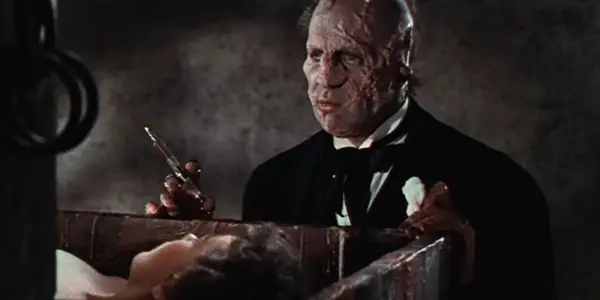
Where the love of his art brought about masterpieces, his scarred form and desire for vengeance brought about a new fascination with brutality towards women in history – catering to the desire of an audience to see it. While it is in the background, it is a constant image every time the film takes you within the museum. And furthering the shock, most of the women selected were smart, clever, and presumed powerful women. Anne Boleyn, Joan of Arc and witches paralleling tp Sue Allen’s intelligence, prowess, and independence and her almost demise at the hands of a man. Granted the police would never have solved the crime without her, there is a clear message – there is no fairytale ending for that kind of woman.
A trip to the past
If there is one thing House of Wax will do is definitely give you a new way to view wax museums going forward. I am not sure I can entirely look at Madame Toussand’s the same again. And while House of Wax boasts an impressive performance by Vincent Price, a strong induction into the history of the horror genre, and proof that remakes are not all bad, it does give viewers perspective into the portrayal of women, both in the forefront and background, displaying how far we have come in the horror genre – and how far we have still yet to go.
What do you think of House of Wax? Let us know in the comments below!
Watch House of Wax
Does content like this matter to you?
Become a Member and support film journalism. Unlock access to all of Film Inquiry`s great articles. Join a community of like-minded readers who are passionate about cinema - get access to our private members Network, give back to independent filmmakers, and more.













